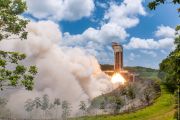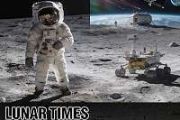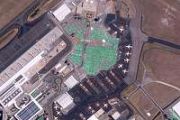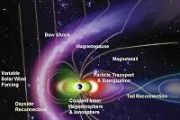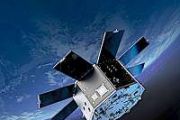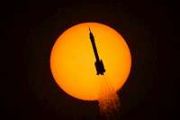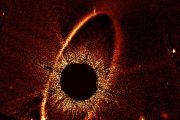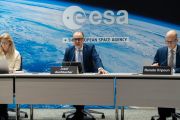
Copernical Team
Army Space Training Strategy - An all of Army approach
 The U.S. Army Space and Missile Defense Command, in close collaboration with U.S. Army Forces Command and U.S. Army Training and Doctrine Command, released the latest iteration of the Army Space Training Strategy, or ASTS, in late 2024. The updated ASTS provides a framework that focuses on how Army space will help build the Army of 2030 and beyond through space education and training.
Firs
The U.S. Army Space and Missile Defense Command, in close collaboration with U.S. Army Forces Command and U.S. Army Training and Doctrine Command, released the latest iteration of the Army Space Training Strategy, or ASTS, in late 2024. The updated ASTS provides a framework that focuses on how Army space will help build the Army of 2030 and beyond through space education and training.
Firs Aerospace engineers to study motion sickness in space
 Don't tell Neil Armstrong, but giant leaps for mankind may leave astronauts feeling a little queasy.
In a new experiment, aerospace engineers at the University of Colorado Boulder will work with astronauts to study how people experience motion sickness when they travel to space-with an eye toward reducing these sometimes debilitating symptoms.
The research is part of the first-of-its
Don't tell Neil Armstrong, but giant leaps for mankind may leave astronauts feeling a little queasy.
In a new experiment, aerospace engineers at the University of Colorado Boulder will work with astronauts to study how people experience motion sickness when they travel to space-with an eye toward reducing these sometimes debilitating symptoms.
The research is part of the first-of-its Redwire expands space-based pharmaceutical research under new NASA contract
 Redwire Corporation (NYSE: RDW), a space infrastructure company serving the growing space economy, has secured a new NASA contract to send four additional pharmaceutical studies to the International Space Station. These investigations will utilize Redwire's proprietary Pharmaceutical In-space Laboratory (PIL-BOX) to support production of high-value seed crystals, laying the groundwork for future
Redwire Corporation (NYSE: RDW), a space infrastructure company serving the growing space economy, has secured a new NASA contract to send four additional pharmaceutical studies to the International Space Station. These investigations will utilize Redwire's proprietary Pharmaceutical In-space Laboratory (PIL-BOX) to support production of high-value seed crystals, laying the groundwork for future Radiation belt wisp mapped inside anomaly by Macao satellite
 This research, led by Professor Zong of Peking University in collaboration with the State Key Laboratory of Lunar and Planetary Science at Macau University of Science and Technology, has yielded new insights into energetic electron dynamics near Earth. The team employed the Medium-energy Electron Spectrometer onboard Macao Science Satellite-1 (MSS-1), which offers full pitch angle measurements i
This research, led by Professor Zong of Peking University in collaboration with the State Key Laboratory of Lunar and Planetary Science at Macau University of Science and Technology, has yielded new insights into energetic electron dynamics near Earth. The team employed the Medium-energy Electron Spectrometer onboard Macao Science Satellite-1 (MSS-1), which offers full pitch angle measurements i NASA cloud tech empowers private mission planners
 Planning a space mission demands precision-ensuring trajectories align and fuel margins hold is critical to sustaining orbital operations. Continuum Space Systems Inc., based in Pasadena, California, delivers a cloud-native suite that equips mission architects with the tools to verify that their assets are ready for liftoff and long-term success.
The company traces its roots to NASA's Jet
Planning a space mission demands precision-ensuring trajectories align and fuel margins hold is critical to sustaining orbital operations. Continuum Space Systems Inc., based in Pasadena, California, delivers a cloud-native suite that equips mission architects with the tools to verify that their assets are ready for liftoff and long-term success.
The company traces its roots to NASA's Jet Lynk and Turkcell Achieve Milestone in Satellite Mobile Service Trial
 Lynk Global, Inc., a pioneer in satellite-direct-to-device (D2D) communications, has completed a successful demonstration of its proprietary technology in collaboration with Turkcell (NYSE: TKC), Turkiye's largest mobile provider, serving over 40 million users. This joint initiative marks a significant advancement in Lynk's ongoing mission to deploy D2D connectivity across Turkiye, following a p
Lynk Global, Inc., a pioneer in satellite-direct-to-device (D2D) communications, has completed a successful demonstration of its proprietary technology in collaboration with Turkcell (NYSE: TKC), Turkiye's largest mobile provider, serving over 40 million users. This joint initiative marks a significant advancement in Lynk's ongoing mission to deploy D2D connectivity across Turkiye, following a p Fluorescent caves could explain how life persists in extraterrestrial environments
 Deep below Earth's surface, rock and mineral formations lay hidden with a secret brilliance. Under a black light, the chemicals fossilized within shine in brilliant hues of pink, blue and green. Scientists are using these fluorescent features to understand how the caves formed and how life is supported in extreme environments, which may reveal how life could persist in faraway places, like Jupit
Deep below Earth's surface, rock and mineral formations lay hidden with a secret brilliance. Under a black light, the chemicals fossilized within shine in brilliant hues of pink, blue and green. Scientists are using these fluorescent features to understand how the caves formed and how life is supported in extreme environments, which may reveal how life could persist in faraway places, like Jupit China sends regenerative flatworms to orbit for biological research
 China's space station will soon host an unusual biological subject for experimentation: the planarian, a species of flatworm distinguished by its extraordinary regenerative powers, according to a report from China Media Group.
With an evolutionary lineage dating back more than 520 million years, planarians are a staple in laboratory research. Their unique ability to completely regenerate b
China's space station will soon host an unusual biological subject for experimentation: the planarian, a species of flatworm distinguished by its extraordinary regenerative powers, according to a report from China Media Group.
With an evolutionary lineage dating back more than 520 million years, planarians are a staple in laboratory research. Their unique ability to completely regenerate b Star-mapping space telescope Gaia sent into 'retirement orbit'
 After more than a decade mapping out our home galaxy, the Gaia space telescope was powered down and sent into "retirement orbit" around the Sun on Thursday, the European Space Agency said.
Since launching in 2013, the telescope has been charting the positions, motion and properties of nearly two billion stars to create a vast map of the Milky Way, revealing many secrets of the cosmos along t
After more than a decade mapping out our home galaxy, the Gaia space telescope was powered down and sent into "retirement orbit" around the Sun on Thursday, the European Space Agency said.
Since launching in 2013, the telescope has been charting the positions, motion and properties of nearly two billion stars to create a vast map of the Milky Way, revealing many secrets of the cosmos along t Super Earth uncovered by tandem space observations
 An international research collaboration, including scientists from the University of Geneva (UNIGE) and the National Centre of Competence in Research PlanetS, has identified a new super-Earth circling a star cooler than the Sun. The planet, named TOI-512 b, was confirmed through precision measurements by ESPRESSO, a spectrograph developed under the leadership of UNIGE. With a density nearly iden
An international research collaboration, including scientists from the University of Geneva (UNIGE) and the National Centre of Competence in Research PlanetS, has identified a new super-Earth circling a star cooler than the Sun. The planet, named TOI-512 b, was confirmed through precision measurements by ESPRESSO, a spectrograph developed under the leadership of UNIGE. With a density nearly iden 











